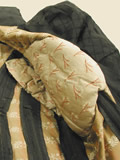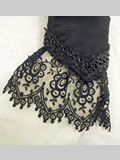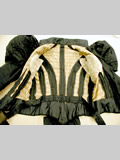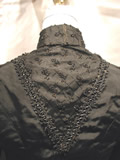The garment I choose to reproduce for this project is in the University of North Carolina's vintage costume collection, Costar. The item is an evening bodice, made of black silk faille. This bodice dates from the early 1890s, probably around 1892-93. The garment can be dated because of a few details which are indicative of this time period; the most important is the size and shape of the sleeves. The leg-o-mutton shape, which is quite full at the shoulder but narrows to a fitted wrist, was very popular at this time. In the years before this, the fashion emphasis was on the bustle area, sleeves and shoulders remained smaller. However, as the bustle style began to disappear, sleeves began to get larger, reaching their fullest point around 1895. While the sleeves on this bodice are quite voluminous, they are not as full as some which would come later in time. This fact helps date this bodice before 1895. Also the sleeve puffs which add to the fullness are made of a contrasting fabric which is another trait of the time period. Contrasting fabrics draws attention and further emphasizes the bulk of the sleeve cap. The bodice is also closely fitted with a small waist line, and fullness in the chest/bust area. This "hourglass" silhouette is a change from the large bustle which had been popular in the period just before this. This bodice would have been worn over a corset, with a long flared skirt. The skirt shape at this time was flared but not yet the trumpet shape. Skirts of this period were often cut straight to bias with the fullness pleated into the back.
Bodice Details
This bodice is beautifully made and a fine example of the craftsmanship of the day. The bodice is a double darted, fitted bodice. It has eleven covered bones on the interior, with a bone on each of the front darts and one on all the interior seams. The majority of the bodice is made of a black silk faille. There are also sleeve puffs made of a patterned black on black, woven silk design. The bodice is flat lined to a tan, glazed cotton with a cream colored print on it, and the sleeves have been flat lined with brown, glazed cotton. Also there are two interior pads in the chest area made of a tan colored, printed cotton, very similar to, but not the same as the bodice flat lining material.
The bodice was constructed from eight pattern pieces. The center front piece has two darts on each side. The dart closest to center front, points to the bust and measures eleven inches. The second dart is also eleven inches in length and runs along the edge of the bust. This front pattern piece goes from center front to the under arm seam which is set towards the back. The back is made up of the remaining six panels with a seam at center back.
The bodice closes down center front with twenty hooks and loops, including three on the collar. On the interior there is a waist tape made of black grosgrain ribbon which joins at the waist, center front with one hook and loop. This tape would have secured the garment snuggly around the wearer so that it would not shift, and it also takes some pressure off the center front closure.
The bodice has a stand collar measuring 1 7/8" which has been stiffened. The collar has been made from the same fabric as the sleeve puffs and then covered with a decorative net. The collar opens at center front.
This garment has a beautiful sleeve shape which adds to the overall esthetic appeal of the bodice. The sleeve is a two-part, shaped sleeve which curves towards the front. The sleeve is very close fitting down to the cuff but is accentuated by an added sleeve puff at the shoulder. The additional puff gives it a leg-o-mutton appearance but allows the sleeve to be quite fitted even up towards the shoulder where a traditional leg-o-mutton cut would not allow this. The sleeve has been eased unto the arms eye with gathering on both the under sleeve and the sleeve puff on top. The sleeve also has an area of gathering at the elbow approximately three inches long on the over sleeve to allow for ease of bending on this tightly fitted sleeve. The sleeve ends at a point over the knuckles, there is no cuff.
The added sleeve puff is made from a single layer of patterned silk. The design on this fabric was created through the weave rather than a printing process; the design is black on black and visible because of the use of a twill and satin weave. The fabric has been gathered and pleated into the arms eye around the shoulder and then pleated into the seams of the upper and lower sleeve seams for approximately three inches in the front and back. Six inches under the arm are free of this additional sleeve fabric, to allow the arm to move freely. The pointed center front of the bodice and rounded shoulders give the bodice and overall heart shape which lengthens the torso, thins the waist and accentuates the shoulders, helping to give the wearer the ideal silhouette of the time period.
The bodice was constructed with a great deal of care and attention. The interior seams (see image #1) have been cleanly finished by piping them with a piece of silk tape, while the hem has been turned under and finished with a wide piece of black tissue faille. The seams at the arms eye have been finished with an overcast stitch and they have also been basted through the five layers of fabric (bodice, flat lining, sleeve, sleeve lining, and the sleeve puff). The piped interior seams have all been clipped at the waist and piped around this to allow the wearer freedom of movement.
|
Image #1: Interior of bodice |
 |
One of the most distinct features of this bodice is the stunning, beaded decoration that covers the garment. A ¾" beaded braid runs along the center front edge, up to the middle of the shoulders and down the back to form a decorative triangle at center back. Image #2 illustrates this elegant beadwork.
|
Image #2: Detail of beadwork and decorative panels |
 |
The beaded trim, made from a chain of black glass beads forms the border of a triangle at center front, center back and two crescent shapes from the shoulders to the underarm in the front. In these areas a piece of the sleeve fabric has been flat lined to the bodice and then covered with a decorative net. A beaded flower pattern with rows of flowers approximately 7/8" have been beaded onto the net. The edges of this pattern are covered by the beaded braid which forms the border of this decorative area. The collar has also been covered with the sleeve fabric and the beaded flower net. This decorative detail is appealing because both the patterned fabric under, and the beaded net on top, form two distinct patterns with neither overpowering the other but combing to be visually interesting.
The deep triangles in front and back further accentuate the narrow waist and full shoulders popular at the time, as do the rounded shape at the armseye in the front. This design detail truly compliments the shape of the garment. Another area accented by beadwork is over the hands. The sleeves come to a sharp point over the knuckles, and while there is no cuff, the addition of the beaded trim draws the eye to that area, exaggerating the point. Lace has been added to the bottom of the sleeve as well but it is not clear that this lace is original or was a later addition as it only appears in this area.
A final trim detail is a black satin ribbon at the hem of the bodice, as seen in images #3 and 4.. This ribbon measures 1 1/4" with a pleat in it. The ribbon begins at center front on the left side wrapping around to the back where there is a bow at center back. It then returns to the front, where it crosses over the center front opening to hook on the side left. At this closure there is another bow.
Damage
This bodice is in excellent condition. The fabric has been well preserved and most of the beaded decoration remains intact. The garment was constructed with a great deal of care and it appears to have been preserved in the same way. It does not appear to have been altered and remains a fine example of a bodice of this time period.
© Kara Monroe, 2004










